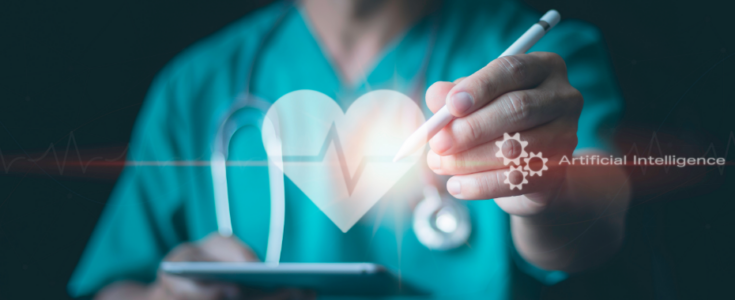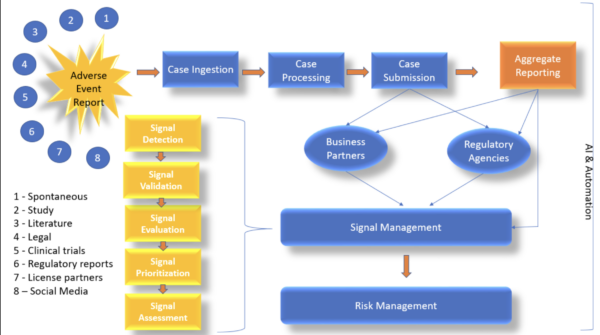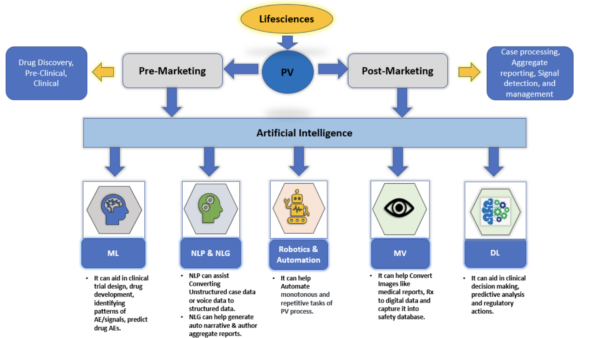

Artificial Intelligence (AI) and Intelligent Automation (IA) have emerged as game-changing technologies in various industries, and the healthcare and life sciences sectors are no exception. With advancements in machine learning (ML), natural language processing (NLP), natural language generation (NLG), deep learning (DL), predictive analysis, robotic process automation (RPA), these technologies are revolutionizing processes in pharmacovigilance (PV), clinical trials, and other life sciences fields. This blog explores the potential of AI and IA in improving efficiency, accuracy, and patient safety in PV. By automating routine tasks and leveraging AI algorithms, healthcare professionals can focus on critical decision-making and enhance overall outcomes.
Also read:
Ecopharmacovigilance (EPV) in Practice: Evolution, Best Practices, Developments
Addressing Environmental Contamination from Healthcare Industry with Ecopharmacovigilance
PV plays a crucial role in monitoring drug safety and implementing risk reduction measures. Traditionally, PV processes have been manual and time-consuming, leaving room for errors and missing critical data. However, with the integration of AI and IA, PV activities can be significantly improved. AI enables the identification of adverse drug events and new safety signals, ensuring patient safety. For instance, AI algorithms have been successful in identifying safety signals for newly approved medications within weeks, facilitating prompt actions to protect patients. IA can not only optimize numerous labor-intensive, but also recurring tasks and enhance consistency. By leveraging AI and automation, healthcare professionals can enhance workflow efficiency and reduce time spent on tasks, ultimately improving patient care.

Figure 1: Complete PV process with potential automation areas
PV industries now rely on NLP and text-mining to collect information from accessible, unstructured sources. Data is extracted from image sources using OCR, ICR, and OMR to monitor adverse effects and drug reactions. AI models can improve clinical trial design and patient selection by reducing demographic heterogeneity and providing prognostic and predictive enrichment. AI also enables real-time analysis of clinical trial data, leading to faster trend discovery and informed decision-making.
These advancements result in improved drug discovery, safer trials, and better patient outcomes at affordable rates. Overall, AI and IA technologies address the increasing data complexity, enhance efficiency, ensure safety monitoring, comply with regulations, and support drug development and real-world evidence integration. They transform life sciences by enhancing patient safety, optimizing processes, accelerating research, and enabling effective decision-making.

Figure 2: Opportunities to improve PV and other life sciences space with AI and IA technologies.
While the benefits of AI and IA in PV are evident, several challenges need to be addressed.
However, these challenging areas are being addressed by regulatory authorities and the pharmaceutical industry, ensuring that the benefits of AI and intelligent automation can be fully harnessed.
AI and IA technologies have the potential to revolutionize PV and other life sciences practices. By incorporating these technologies at every stage, from drug discovery to post-marketing stages, healthcare professionals can experience increased efficiency, accuracy, and quality of data, reduced workload, improved compliance, and enhanced patient safety. The adoption of AI-enabled automated PV systems is on the rise, and while challenges remain, the undeniable benefits will drive further advancements in these fields. As technology evolves and gains wider acceptance, we can expect significant breakthroughs and improvements in drug safety, clinical trials, and overall patient care.
The Apexon sustainability framework helps speed up transformation of the net zero journey as soon as you have defined your strategy and ambitions for a sustainable future. Our transformational approach across the IT value chain not only focuses on the internal IT but also enterprise and customer operations. Apexon provides you with utmost transparency to sustainability goals by leveraging reliable data. We embrace AI to power sustainable actions. Our 5-step approach helps businesses embed sustainability data and performance into everything they do to effectively measure the business value and sustainable impact for all stakeholders.
To learn more about Apexon’s sustainability analytics framework, get in touch using the form below.
Also read: Empowering Discovery: The Role of RAG Architecture & Generative AI in Healthcare & Life Sciences